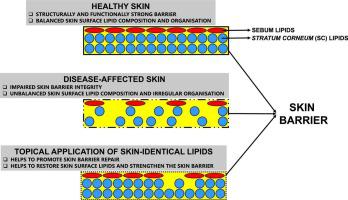Progress in Lipid Research ( IF 13.6 ) Pub Date : 2023-11-06 , DOI: 10.1016/j.plipres.2023.101264 Dalibor Mijaljica 1 , Joshua P Townley 1 , Fabrizio Spada 1 , Ian P Harrison 1

|
The outermost epidermal layer of the skin, the stratum corneum, is not simply a barrier that safeguards skin integrity from external insults and invaders, it is also a delicately integrated interface composed of firm, essentially dead corneocytes and a distinctive lipid matrix. Together, the stratum corneum lipid matrix and sebum lipids derived from sebaceous glands give rise to a remarkably complex but quite unique blend of skin surface lipids that demonstrates tremendous heterogeneity and provides the skin with its indispensable protective coating. The stratum corneum lipid matrix is composed primarily of three major lipid classes: ceramides, non-esterified fatty acids and cholesterol, whereas sebum is a waxy mixture predominantly composed of acylglycerols, wax esters, non-esterified fatty acids, squalene, cholesterol and cholesterol esters. The balance of these skin surface lipids in terms of their relative abundance, composition, molecular organisation and dynamics, and their intricate interactions play a crucial role in the maintenance of healthy skin. For that reason, even minuscule alterations in skin surface lipid properties or overall lipid profile have been implicated in the aetiology of many common skin diseases including atopic dermatitis, psoriasis, xerosis, ichthyosis and acne. Novel lipid-based interventions aimed at correcting the skin surface lipid abnormalities have the potential to repair skin barrier integrity and the symptoms associated with such skin diseases, even though the exact mechanisms of lipid restoration remain elusive.
中文翻译:

人类皮肤健康和疾病中皮肤表面脂质的异质性和复杂性
皮肤的最外表皮层,即角质层,不仅仅是保护皮肤完整性免受外部侵害和入侵者侵害的屏障,它也是由坚固的、基本上死亡的角质细胞和独特的脂质基质组成的微妙整合的界面。角质层脂质基质和来自皮脂腺的皮脂脂质共同产生了一种非常复杂但相当独特的皮肤表面脂质混合物,它表现出巨大的异质性,并为皮肤提供了不可或缺的保护层。角质层脂质基质主要由三种主要脂质类别组成:神经酰胺、非酯化脂肪酸和胆固醇,而皮脂是蜡状混合物,主要由酰基甘油、蜡酯、非酯化脂肪酸、角鲨烯、胆固醇和胆固醇酯组成。这些皮肤表面脂质在相对丰度、组成、分子组织和动力学方面的平衡以及它们复杂的相互作用在维持健康皮肤中发挥着至关重要的作用。因此,即使皮肤表面脂质特性或总体脂质谱的微小变化也与许多常见皮肤病的病因有关,包括特应性皮炎、牛皮癣、干燥病、鱼鳞病和痤疮。旨在纠正皮肤表面脂质异常的新型脂质干预措施有可能修复皮肤屏障完整性和与此类皮肤病相关的症状,尽管脂质恢复的确切机制仍然难以捉摸。































 京公网安备 11010802027423号
京公网安备 11010802027423号